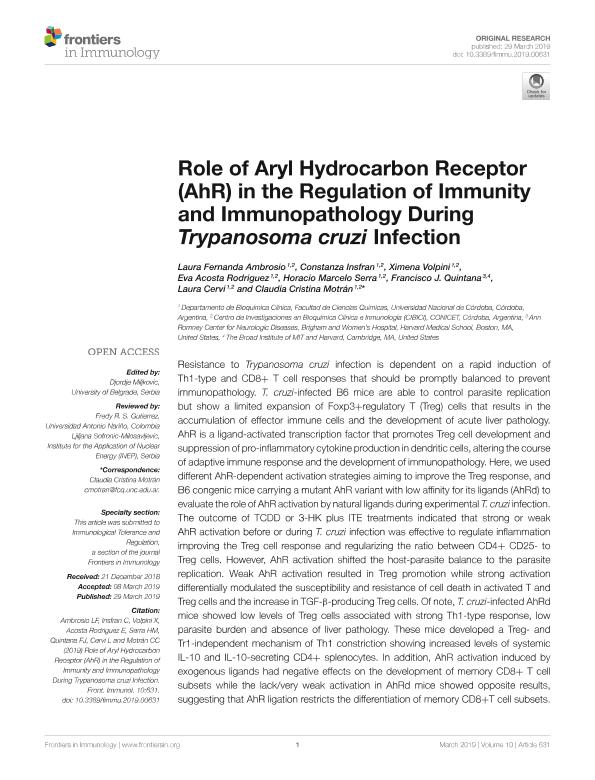Mostrar el registro sencillo del ítem
dc.contributor.author
Ambrosio, Laura Fernanda

dc.contributor.author
Insfran, Constanza

dc.contributor.author
Volpini, Ximena

dc.contributor.author
Acosta Rodriguez, Eva Virginia

dc.contributor.author
Serra, Horacio Marcelo

dc.contributor.author
Quintana, Francisco Javier

dc.contributor.author
Cervi, Laura Alejandra

dc.contributor.author
Motran, Claudia Cristina

dc.date.available
2021-03-26T21:12:20Z
dc.date.issued
2019-07
dc.identifier.citation
Ambrosio, Laura Fernanda; Insfran, Constanza; Volpini, Ximena; Acosta Rodriguez, Eva Virginia; Serra, Horacio Marcelo; et al.; Role of aryl hydrocarbon receptor (AhR) in the regulation of immunity and immunopathology during trypanosoma cruzi infection; Frontiers Media S.A.; Frontiers in Immunology; 10; MAR; 7-2019; 631-641
dc.identifier.uri
http://hdl.handle.net/11336/129081
dc.description.abstract
Resistance to Trypanosoma cruzi infection is dependent on a rapid induction of Th1-type and CD8+ T cell responses that should be promptly balanced to prevent immunopathology. T. cruzi-infected B6 mice are able to control parasite replication but show a limited expansion of Foxp3+regulatory T (Treg) cells that results in the accumulation of effector immune cells and the development of acute liver pathology. AhR is a ligand-activated transcription factor that promotes Treg cell development and suppression of pro-inflammatory cytokine production in dendritic cells, altering the course of adaptive immune response and the development of immunopathology. Here, we used different AhR-dependent activation strategies aiming to improve the Treg response, and B6 congenic mice carrying a mutant AhR variant with low affinity for its ligands (AhRd) to evaluate the role of AhR activation by natural ligands during experimental T. cruzi infection. The outcome of TCDD or 3-HK plus ITE treatments indicated that strong or weak AhR activation before or during T. cruzi infection was effective to regulate inflammation improving the Treg cell response and regularizing the ratio between CD4+ CD25- to Treg cells. However, AhR activation shifted the host-parasite balance to the parasite replication. Weak AhR activation resulted in Treg promotion while strong activation differentially modulated the susceptibility and resistance of cell death in activated T and Treg cells and the increase in TGF-β-producing Treg cells. Of note, T. cruzi-infected AhRd mice showed low levels of Treg cells associated with strong Th1-type response, low parasite burden and absence of liver pathology. These mice developed a Treg- and Tr1-independent mechanism of Th1 constriction showing increased levels of systemic IL-10 and IL-10-secreting CD4+ splenocytes. In addition, AhR activation induced by exogenous ligands had negative effects on the development of memory CD8+ T cell subsets while the lack/very weak activation in AhRd mice showed opposite results, suggesting that AhR ligation restricts the differentiation of memory CD8+T cell subsets. We propose a model in which a threshold of AhR activation exists and may explain how activation or inhibition of AhR-derived signals by infection/inflammation-induced ligands, therapeutic interventions or exposure to pollutants can modulate infections/diseases outcomes or vaccination efficacy.
dc.format
application/pdf
dc.language.iso
eng
dc.publisher
Frontiers Media S.A.
dc.rights
info:eu-repo/semantics/openAccess
dc.rights.uri
https://creativecommons.org/licenses/by-nc-sa/2.5/ar/
dc.subject
AHR
dc.subject
CHAGAS DISEASE
dc.subject
ITE
dc.subject
REGULATORY T CELLS
dc.subject
TCDD
dc.subject.classification
Parasitología

dc.subject.classification
Ciencias de la Salud

dc.subject.classification
CIENCIAS MÉDICAS Y DE LA SALUD

dc.title
Role of aryl hydrocarbon receptor (AhR) in the regulation of immunity and immunopathology during trypanosoma cruzi infection
dc.type
info:eu-repo/semantics/article
dc.type
info:ar-repo/semantics/artículo
dc.type
info:eu-repo/semantics/publishedVersion
dc.date.updated
2020-11-25T17:49:33Z
dc.identifier.eissn
1664-3224
dc.journal.volume
10
dc.journal.number
MAR
dc.journal.pagination
631-641
dc.journal.pais
Suiza

dc.journal.ciudad
Lausana
dc.description.fil
Fil: Ambrosio, Laura Fernanda. Consejo Nacional de Investigaciones Científicas y Técnicas. Centro Científico Tecnológico Córdoba. Centro de Investigaciones en Bioquímica Clínica e Inmunología; Argentina. Universidad Nacional de Córdoba; Argentina
dc.description.fil
Fil: Insfran, Constanza. Universidad Nacional de Córdoba; Argentina. Consejo Nacional de Investigaciones Científicas y Técnicas. Centro Científico Tecnológico Córdoba. Centro de Investigaciones en Bioquímica Clínica e Inmunología; Argentina
dc.description.fil
Fil: Volpini, Ximena. Consejo Nacional de Investigaciones Científicas y Técnicas; Argentina. Consejo Nacional de Investigaciones Científicas y Técnicas. Centro Científico Tecnológico Conicet - Córdoba. Instituto de Investigación Médica Mercedes y Martín Ferreyra. Universidad Nacional de Córdoba. Instituto de Investigación Médica Mercedes y Martín Ferreyra; Argentina
dc.description.fil
Fil: Acosta Rodriguez, Eva Virginia. Universidad Nacional de Córdoba; Argentina. Consejo Nacional de Investigaciones Científicas y Técnicas. Centro Científico Tecnológico Córdoba. Centro de Investigaciones en Bioquímica Clínica e Inmunología; Argentina
dc.description.fil
Fil: Serra, Horacio Marcelo. Universidad Nacional de Córdoba; Argentina. Consejo Nacional de Investigaciones Científicas y Técnicas. Centro Científico Tecnológico Córdoba. Centro de Investigaciones en Bioquímica Clínica e Inmunología; Argentina
dc.description.fil
Fil: Quintana, Francisco Javier. The Broad Institute of MIT and Harvard; Estados Unidos. Harvard Medical School; Estados Unidos
dc.description.fil
Fil: Cervi, Laura Alejandra. Universidad Nacional de Córdoba; Argentina. Consejo Nacional de Investigaciones Científicas y Técnicas. Centro Científico Tecnológico Córdoba. Centro de Investigaciones en Bioquímica Clínica e Inmunología; Argentina
dc.description.fil
Fil: Motran, Claudia Cristina. Universidad Nacional de Córdoba; Argentina. Consejo Nacional de Investigaciones Científicas y Técnicas. Centro Científico Tecnológico Córdoba. Centro de Investigaciones en Bioquímica Clínica e Inmunología; Argentina
dc.journal.title
Frontiers in Immunology
dc.relation.alternativeid
info:eu-repo/semantics/altIdentifier/doi/https://doi.org/10.3389/fimmu.2019.00631
dc.relation.alternativeid
info:eu-repo/semantics/altIdentifier/url/https://www.frontiersin.org/articles/10.3389/fimmu.2019.00631/full
Archivos asociados
